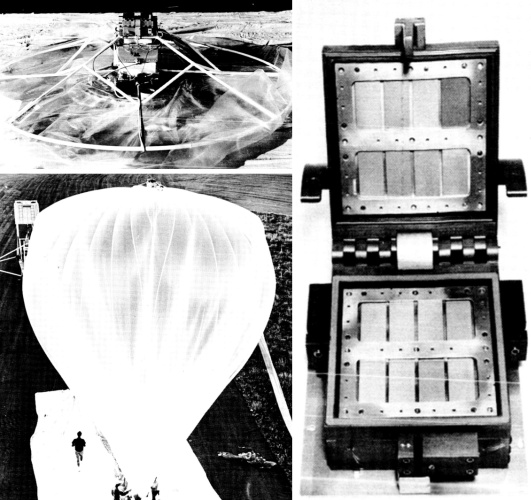Purpose of the flight and payload description
During the decade of 1960, the Dudley Observatory with support of a NASA grant developed a balloon-borne program aimed to collect micrometeorites in the stratosphere for the study of cosmic dust in the upper atmosphere and in space. The device used was dubbed SESAME in a clear reference to the magical phrase that opened the cave in the story of "Ali Baba and the Forty Thieves". SESAME consisted of two units, the collector, located in a special platform in the balloon apex and control gear which was hung from the bottom of the parachute system below the balloon, like in any other conventional balloon-borne mission.
The balloon-top collector is shown in the right-most Figure. It consisted of a rugged anodized aluminum box approximately 7" x 7" x 3" in size and weighing about 12 lbs. Inside the box there were two cassettes each containing eight 1" x 2" slides which were faced upward during exposure and four control slides (not visible) that faced downward, but do not touched the bottom of the cassettes. One cassette was mounted in the cover of the box and the other in the body of the box. In the figure, the box is shown not quite fully open. A silicone rubber gasket was located in the upper rim of the box and mated with the cover to seal the box, at launch and landing. Two types of collection surfaces were used: one made of 200 angstroms thick nitrocellouse slides coated with evaporated aluminum approximately half that thick, and another made of highly polished aluminum slides with thin coated film of mineral oil. To avoid contamination before the flight, the casettes were loaded with the slides in a "dust-free" hood inside a clean room.
An air-bleed containing five millipore filters in series allowed air pressure within the collector to be kept equal to the outside air pressure at all times. The collection device was unlatched at altitude by two parallel sealed squibs (bellows actuators) and opened by an electric motor. Receiver and transmitter, ballast and battery power were located in the bottom payload. Control and power wires were encased in a special sleeve to provide electrical connections between the bottom and top payloads. Opening and closing of the collector was accomplished by ground command while the balloon was at float altitude. Opening, closing, fully-open and completely-closed conditions of the collector were confirmed by a telemetry system. The collector was locked at exposure altitudes with three enclosed steel bolts driven by sealed squibs (bellows actuators) into tongues attached on three sides of the cover.
The upper-left image shows the collector mounted on the framework which holded it above the apex of the balloon during flight. The recovery beacon and parachute housing are also shown. The bottom-left image shows the SESAME collector on top of the bubble of the balloon just prior to launch and part of the bottom payload is barely visible attached to the launch vehicle.
The flight profiles were of two kinds: 1) after the balloon reached the maximum altitude the collector was opened and several hours were spent at float, or 2) the collector was opened during the climbing and once float altitude was reached, it was closed and the mission terminated immediately. Most of the flights were made in coincidence with well known meteor showers like Perseids, Leonids or Taurids, while others that not coincided with any of these showers were used as controls.
The program performed more than 30 flights between 1963 and 1970, when a new collection system was introduced.
Details of the balloon flight
Balloon launched on: 11/17/1965
Launch site: Columbia Scientific Balloon Facility, Palestine, Texas, US
Balloon launched by: NCAR National Scientific Balloon Flight Station
Balloon manufacturer/size/composition: Zero Pressure Balloon Winzen 1.250.000 cuft (1.0 MIL. Stratofilm)
Flight identification number: 186P
End of flight (L for landing time, W for last contact, otherwise termination time): ??/??/1965
Balloon flight duration (F: time at float only, otherwise total flight time in d:days / h:hours or m:minutes - ): 5h 40m
Payload weight: 242 lbs
External references
- Balloon Flight Record Facilities for Atmospheric Research Nº 1, Fall 1966
- Curtis Hemenway, director of the Dudley Observatory showing the SESAME balloon-top meteorite collector Science in Space - 1966
- NCAR Scientific Balloon Facility Annual Report, 1965 National Center for Atmospheric Research, January 1966
3791If you consider this website interesting or useful, you can help me to keep it up and running with a small donation to cover the operational costs. Just the equivalent of the price of a cup of coffee helps a lot.


